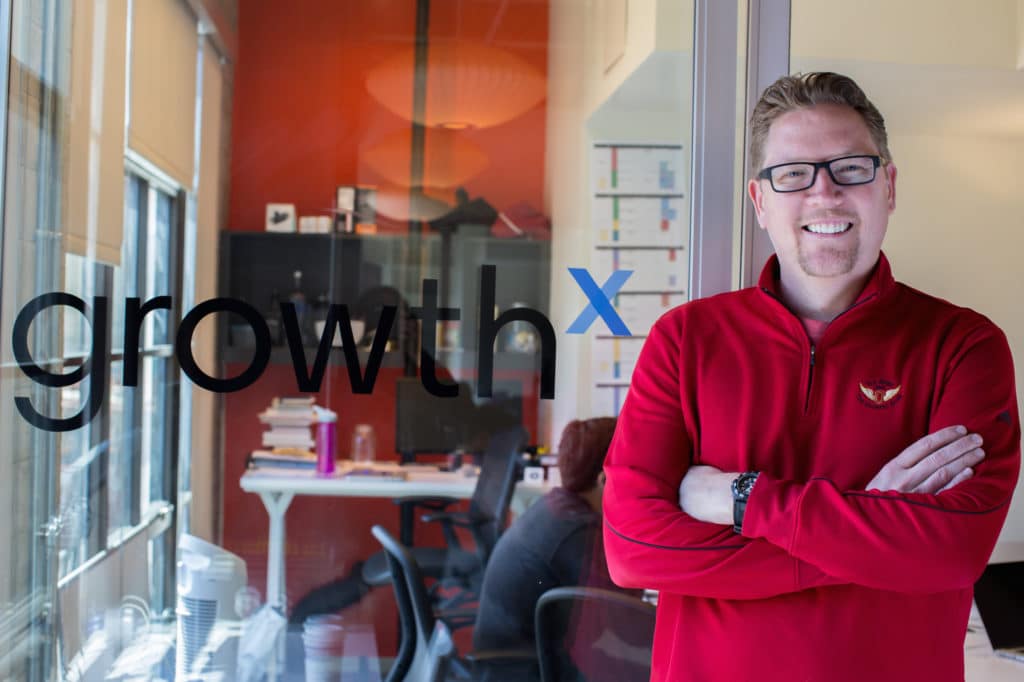Why GrowthX’s Sean Sheppard Preaches Listening, Authenticity and Research as the Pillars of Successful Selling

Current sales culture, for the most part, is entirely concerned with the close.
It’s an understandable focal point, of course. Closing a customer means more revenue for the company, and more revenue for the company means growth. Oh, and closing a customer also means a commission cheque to the sales person responsible. And sales people like commission cheques.
But the close-at-all-costs mentality is flawed, says GrowthX co-founder Sean Sheppard, on a recent edition of The Predictable Revenue Podcast. It creates robotic sales people – hell bent on pitching and demoing, pitching and demoing.
But what we need more than ever are humans willing to listen to other humans to help solve a problem. That’s the foundation of selling. Simply pitching and demoing, adds Sheppard, isn’t helping.
“We can’t forget to be human and bring humanity back to what we do. The market has never been more informed or has had more access to diverse points of view and options and choices as today,” says Sheppard.
“We already know from data that 75% of what someone wants to know about you before they engage you as a prospect, has already been decided. They don’t want the pitch, they don’t want the demo. They don’t care about the product. What they’ve done is connect the dots between your product and their problem and they want to see if that is actually the case. The problem is we don’t do the same in return.”
So…what should we be doing in return? How should we as salespeople engage our prospects?
According to Sheppard, true engagement begins with simple messaging entirely focused on learning about the business problems they are experiencing, and then sharing how you’ve helped similar people with similar issues.
This is the foundation of an effective sales conversation.
“You need to walk into a call prepared with preliminaries – you need to know your company, you need to know your prospect, and you need to define your value. You need to quantify that value, lead with value,” says Sheppard.
“But focus on the problem you solve and submit power and control to your prospect. Then, based on what they tell you, don’t just follow your check boxes, operate within the framework of the conversation. That establishes credibility and earns you the right to ask the questions you want to ask.”
A successful sales call, more often than not, leads to another call with more people. And it’s up to the salesperson, of course, to understand the role and needs of each new person that enters the conversation.
According to Sheppard, there four buyer types one may encounter along the sales journey.
They are:
- User buyer – the team member that will actually use the tool in question;
- Economic buyer – the team member that will, hopefully, write the cheque;
- Technical buyer – the team member that will integrate the tool into existing the existing tech ecosystem;
- Champion – the team member that sees the biggest gain from doing business with you (sees how great life can be with your product).
Your champion, says Sheppard, can be any of the other three buyer types. The economic buyer, on the other hand, stands alone.
The key to speaking with technical buyers is to understand they can say no to your product, as they are the ones who are often tasked with doing the heavy lifting in terms of integrations and any other necessary back end work. The technical buyers, Sheppard stresses, should get involved in the sales discussion as early as possible.
If these steps – simple messaging, effective listening, understanding different buyer types – are followed, then the close (that all might close!) will happen as a natural byproduct of the process, not just a step you’re forcing everyone involved to get to.
And, of course, the close won’t come as a result of pitching and demoing.
“The idea that a demo gets you to a close is flawed thinking,” says Sheppard. “It’s their situation, the problems associated with it, and how life may be like without those pains.”
Elevating the profession
It’s no secret that the sales professional doesn’t enjoy the best of reputations. Snake oil pushers used car dealers – the list goes on.
But it doesn’t have to be that way, stresses Sheppard. The sales profession touches many people during their careers and makes a lot of people money.
It’s actually a positive thing.
“It frustrates me that sales is miscategorized. There are 6,000 universities in the U.S., and less than 100 have sales programming. About 50% of college graduates end up in sales at some point in their career,” says Sheppard.
“The profession has a high average earned income, low divorce rate, high job satisfaction rates. It should be elevated. It should be a degreed thing.”
And with so much of the success of a business, startup or otherwise, resting on sales, the future is bright for trained salespeople. In fact, poor market development (taking a product that has identified prospects and revenue) is the reason most companies fail, says Sheppard.
“Think about it, with all the money we throw at building products, why is our failure rate still 70%? It’s because eight of the top 10 reasons for failure has to do with the market and people,” says Sheppard.
“Of those, six are market-related and two are people related. People can kill anything is they want to, or destroy it through ego etc. The rest is the market and lack of adoption. Only two are product related – yet still, everyone is focused on product and they believe if they build it, people will come.”
For more on Sheppard’s views on sales fundamentals and the state of the industry, check out his recent edition of The Predictable Revenue Podcast.
NO TIME TO READ?
Listen On:
